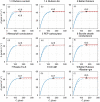A cross-scale analysis to understand and quantify the effects of photosynthetic enhancement on crop growth and yield across environments
- PMID: 36200623
- PMCID: PMC10091820
- DOI: 10.1111/pce.14453
A cross-scale analysis to understand and quantify the effects of photosynthetic enhancement on crop growth and yield across environments
Abstract
Photosynthetic manipulation provides new opportunities for enhancing crop yield. However, understanding and quantifying the importance of individual and multiple manipulations on the seasonal biomass growth and yield performance of target crops across variable production environments is limited. Using a state-of-the-art cross-scale model in the APSIM platform we predicted the impact of altering photosynthesis on the enzyme-limited (Ac ) and electron transport-limited (Aj ) rates, seasonal dynamics in canopy photosynthesis, biomass growth, and yield formation via large multiyear-by-location crop growth simulations. A broad list of promising strategies to improve photosynthesis for C3 wheat and C4 sorghum were simulated. In the top decile of seasonal outcomes, yield gains were predicted to be modest, ranging between 0% and 8%, depending on the manipulation and crop type. We report how photosynthetic enhancement can affect the timing and severity of water and nitrogen stress on the growing crop, resulting in nonintuitive seasonal crop dynamics and yield outcomes. We predicted that strategies enhancing Ac alone generate more consistent but smaller yield gains across all water and nitrogen environments, Aj enhancement alone generates larger gains but is undesirable in more marginal environments. Large increases in both Ac and Aj generate the highest gains across all environments. Yield outcomes of the tested manipulation strategies were predicted and compared for realistic Australian wheat and sorghum production. This study uniquely unpacks complex cross-scale interactions between photosynthesis and seasonal crop dynamics and improves understanding and quantification of the potential impact of photosynthesis traits (or lack of it) for crop improvement research.
Keywords: APSIM; crop growth modelling; crop production; cross-scale model; electron transport-limited photosynthesis; enzyme-limited photosynthesis; yield improvement.
© 2022 The Authors. Plant, Cell & Environment published by John Wiley & Sons Ltd.
Figures







References
-
- Ababaei, B. & Chenu, K. (2020) Heat shocks increasingly impede grain filling but have little effect on grain setting across the Australian Wheatbelt. Agricultural and Forest Meteorology, 284, 107889.
-
- Ainsworth, E.A. & Long, S.P. (2021) 30 years of free‐air carbon dioxide enrichment (FACE): what have we learned about future crop productivity and its potential for adaptation? Global Change Biology, 27, 27–49. - PubMed
-
- Brown, H.E. , Huth, N.I. , Holzworth, D.P. , Teixeira, E.I. , Zyskowski, R.F. & Hargreaves, J.N.G. et al. (2014) Plant modelling framework: software for building and running crop models on the APSIM platform. Environmental Modelling & Software, 62, 385–398.
MeSH terms
Substances
LinkOut - more resources
Full Text Sources
Miscellaneous

